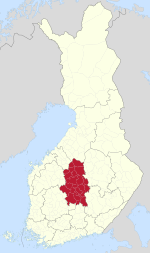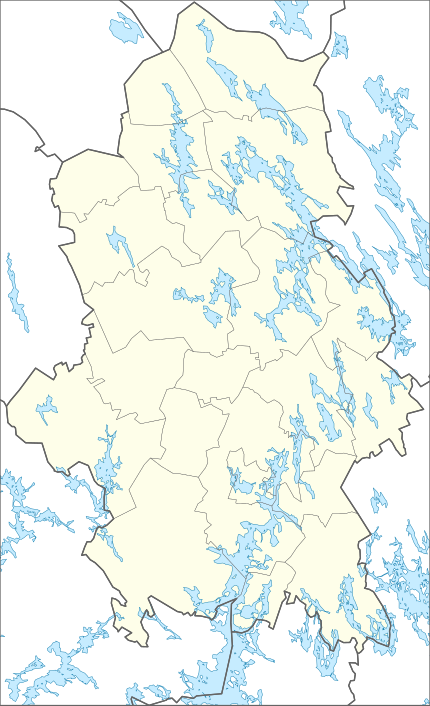|
Central Finland
Central Finland (Finnish: Keski-Suomi; Swedish: Mellersta Finland) is a region (maakunta / landskap) in Finland. It borders the regions of Päijät-Häme, Pirkanmaa, South Ostrobothnia, Central Ostrobothnia, North Ostrobothnia, North Savo, and South Savo. The city of Jyväskylä is the regional centre and by far the largest city in the area. The Central Finland lies slightly south of the geographical centre of Finland. The landscape is hilly and a large part of the province belongs to the Finnish Lakeland.[2]  The largest lake in the very water-based region is Lake Päijänne (1,080 km2). Other large lakes are Lake Keitele (490 km2), Lake Konnevesi (190 km2) and Lake Kivijärvi (150 km2). The highest point in the region is Kiiskilänmäki in the municipality of Multia, which reaches an altitude of 269 meters above sea level.[4] Kuokanjoki, Finland's shortest river and one of the world's shortest rivers is in the region.[5][6] Central Finland has been one of the slowly growing regions in terms of population, but the growth has been based on the Jyväskylä sub-region's position as a significant growth center, and most of the region's municipalities are declining in population.[7][8] Also, of these, Kyyjärvi has landed on the Finnish state's crisis financial management list due to its economic hardship.[9][10] Luhanka, the smallest municipality in the whole Mainland Finland in terms of population, is also located in the region.[11][12] HistoryThe idea of a province of Central Finland was born at the end of the 19th century. The concept was developed by the district doctor Wolmar Schildt, whose article for Suometar first appeared in 1856. In the late 19th and early 20th centuries, the provincial identity of Central Finland was strengthened by associations, organisations and companies that expanded into the provinces. The Central Finland Province was established in 1960, but was abolished in the county reform of 1997.[2] A province is a common administrative unit based on the autonomous decision-making power of municipalities and embodies local democracy at the regional level vis-à-vis the state, while a county is a regional administrative unit of the state. The Central Finland covers almost the same geographical area as the former Central Finland Province. At that time, the province of Central Finland was merged with the provinces of Turku and Pori and Vaasa and the northern parts of Tavastia to form the Western Finland Province. The current Central Finland is larger than the former province of Central Finland, as Jämsä was joined with Kuorevesi and part of Längelmäki, which previously belonged to Pirkanmaa.[2] Kuhmoinen was also part of Central Finland until 2021, when it joined the region of Pirkanmaa. Historical provincesFor history, geography and culture see: Tavastia, Savonia, Ostrobothnia MunicipalitiesThe region of Central Finland consists of 22 municipalities, six of which have city status (marked in bold). Municipalities on the mapSub-regions
List of municipalities
PoliticsResults of the 2019 Finnish parliamentary election in Central Finland:
References
External links
|
||||||||||||||||||||||||||||||||||||||||||||||||||||||||||||||||||||||||||||||||||||||||||||||||||||||||||||||||||||||||||||||||||||||||||||||||||||||||||||||||||||||||||||||||||||||||||||||||||||||||||||||||||||||||||||||||||||||||||||||||||||||||||


























